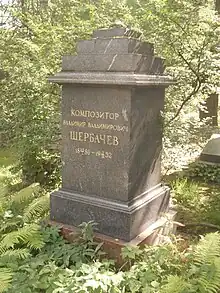
Vladimir Vladimirovich Shcherbachov (Shcherbachyov, Shcherbachev) (Russian: Влади́мир Влади́мирович Щербачёв; 24 January 1889, in Warsaw – 5 March 1952, in Leningrad) was a Soviet composer.
He studied with Maximilian Steinberg, Anatoly Lyadov, and Jāzeps Vītols (Joseph Wihtol) at the St. Petersburg Conservatory from 1908 to 1914. While there he also worked as a pianist for Sergey Diaghilev and taught theory. He served in World War I and then worked in Soviet government music positions. In 1918-1923 he worked as a lecturer and ran the musical department of the Narkompros. He later became a professor at the Leningrad Conservatory (1923-1931 and 1944-1948) and the Tbilisi Conservatory. He counted Boris Arapov, Vasily Velikanov, Evgeny Mravinsky, Valery Zhelobinsky, Gavriil Popov, Valerian Bogdanov-Berezovsky, Pyotr Ryazanov, and Mikhail Chulaki among his pupils, as well as various others.[1][2][3][4]
Works
- Anna Kolossova, opera (1939, unfinished);
- Tabachny Kapitan, operetta (1943);
- Five symphonies:
- No. 1 (1914);
- No. 2 ("Blokovskaya” or "Blok", with soloists and chorus, 1925);
- No. 3 (Symphony-Suite, 1931);
- No. 4 ("Izhorskaya", with soloists and chorus, 1935);
- No. 5 ("Russkaya", 1948, 2nd version in 1950);
- Nonet for 7 instruments, voice and dancer (1919);
- Suite for string quartet (1939) and other chamber music;
- Two piano sonatas and other piano works;
- Various Romances;
- Film music:
- The Thunderstorm (after Aleksandr Ostrovsky, 1934);
- Peter I (1937-1939);
- Polkovodets Suvorov (1941);
- Two Suites:
References
- ↑ Haas, Boris Asafyev and Soviet Symphonic Theory, pp. 410-432
- ↑ Grove Music Online
- ↑ siue.edu
- ↑ (ru) saratov-kultura.ru
- ↑ classicalarchives
- ↑ home.online.nl, Internet Edition compiled by Onno van Rijen
- ↑ silvamedal.net
- ↑ bytemusic.es
- Don Randel, The Harvard Biographical Dictionary of Music. Harvard, 1996, p. 831.
- Genrich Orlov, Vladmir Vladimirovich Shcherbachov (Leningrad, 1959)
- Haas, David (1992). "Boris Asafyev and Soviet Symphonic Theory". The Musical Quarterly. 76 (3): 410–432. doi:10.1093/mq/76.3.410.